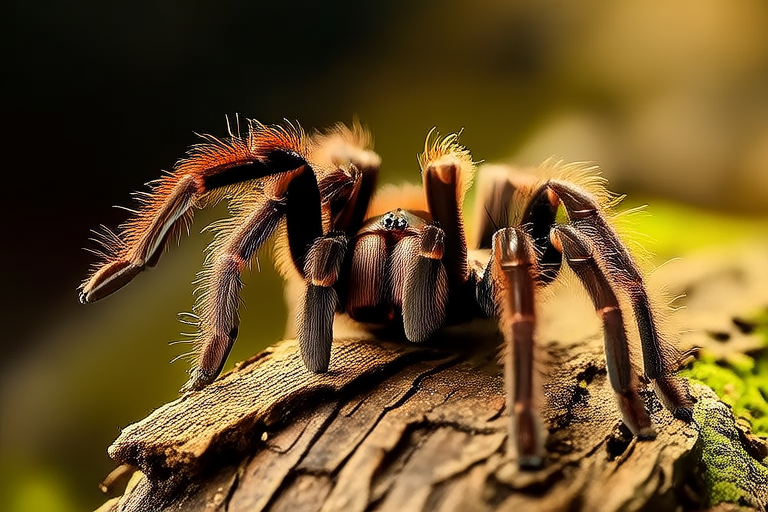From Fear to Fascination: Why Tarantulas Make Unique Pets
Tarantulas often evoke fear and revulsion in many people, but these large, hairy spiders can make surprisingly gentle and fascinating pets. Understanding why these creatures are feared and learning about their unique qualities can help transform fear into fascination.
Common Fears Associated with Tarantulas
One of the most common fears associated with tarantulas is their appearance. Their large size, hairy bodies, and multiple legs can be intimidating to those unfamiliar with them. Another concern is the myth that tarantulas are highly venomous and dangerous. In reality, most tarantulas pose little threat to humans. Their venom is typically no more potent than a bee sting, and they will only bite if they feel threatened or provoked.
Additionally, some people worry about the maintenance and care required for tarantulas as pets. The idea of caring for a creature so different from traditional pets like dogs or cats can seem daunting. However, with proper research and preparation, keeping a tarantula can be both rewarding and educational.
Unique Qualities of Tarantulas as Pets
Despite initial apprehensions, tarantulas offer numerous unique qualities that make them excellent pets. They are relatively low-maintenance compared to other exotic animals, requiring minimal interaction and attention. This makes them ideal for individuals who may not have the time or inclination for more demanding pets.
Moreover, tarantulas are incredibly fascinating creatures. Their behavior, feeding habits, and interactions within their environment provide endless opportunities for observation and learning. For enthusiasts, watching a tarantula molt or hunt can be a captivating experience.
Tarantula Care
Caring for a tarantula involves providing a suitable habitat, appropriate diet, and regular maintenance. A terrarium or enclosure designed specifically for tarantulas is essential. It should include hiding spots, substrate for burrowing, and a water dish. The temperature and humidity levels within the enclosure must also be carefully controlled to mimic the spider’s natural environment.
Dietary requirements vary depending on the species of tarantula. Most adult tarantulas feed primarily on insects such as crickets, roaches, and mealworms. Younger tarantulas may require smaller prey items. Feeding should be done cautiously to avoid overfeeding, which can lead to health issues.
Regular cleaning of the enclosure is necessary to maintain hygiene and prevent disease. Substrate should be changed periodically, and any uneaten food should be removed promptly. Handling tarantulas should be minimized to reduce stress and the risk of injury to both the handler and the spider.
Myths Debunked
Many misconceptions surround tarantulas, contributing to their negative image. One prevalent myth is that all tarantulas are aggressive and prone to biting. While tarantulas can become defensive when threatened, they generally prefer to retreat rather than attack. Another myth is that tarantulas are highly venomous and deadly to humans. As mentioned earlier, their venom is typically mild and poses little danger to humans.
Another misconception is that tarantulas are solitary creatures that cannot coexist peacefully. While tarantulas are primarily solitary animals, there are certain species that can live together in captivity under specific conditions. Researching the particular species you are interested in can provide valuable insights into their social behaviors and housing needs.
Fascinating Behaviors
Tarantulas exhibit a wide range of fascinating behaviors that captivate observers. One of the most remarkable is molting, the process by which tarantulas shed their exoskeletons to grow. During this time, the tarantula becomes vulnerable and will remain immobile until the new exoskeleton hardens. Observing this process can provide a deeper understanding of the tarantula’s lifecycle.
Another intriguing behavior is how tarantulas capture and consume their prey. Many tarantulas use ambush tactics, waiting patiently for prey to come within reach before striking. Once caught, they inject venom to immobilize the prey and then liquefy its insides with digestive enzymes before consuming it. This method of predation showcases the efficiency and adaptability of these spiders.
Some tarantulas also display unique defensive mechanisms. For example, certain species can release hairs from their abdomen as a defense against predators. These hairs can cause irritation to the eyes and skin of potential threats. Other tarantulas may play dead or assume threatening postures to deter attackers.
Tips for Beginners
If you’re considering adopting a tarantula as a pet, there are several tips to keep in mind. First, thoroughly research the species you are interested in to understand its specific care requirements. Different species have varying needs regarding temperature, humidity, diet, and socialization.
Second, invest in high-quality enclosures and equipment. Proper housing is crucial for the health and well-being of your tarantula. Ensure that the enclosure provides ample space for movement, hiding, and burrowing, and that it is escape-proof.
Third, establish a routine for feeding and maintaining the enclosure. Consistency helps create a stable environment for your tarantula and allows you to monitor its health and behavior closely. Finally, seek advice from experienced tarantula keepers or join online communities dedicated to tarantula care. Sharing experiences and knowledge can enhance your understanding and enjoyment of these fascinating creatures.
